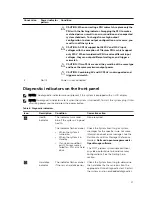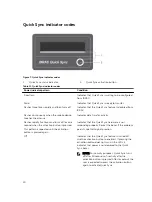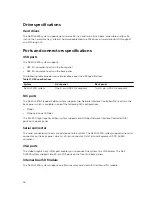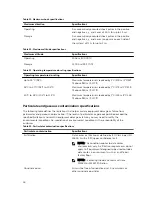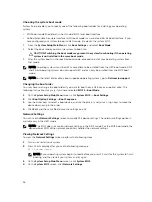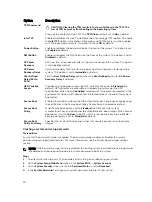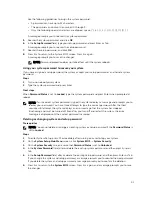
Table 21. Maximum shock specifications
Maximum vibration
Specifications
Operating
Six consecutively executed shock pulses in the positive
and negative x, y, and z axes of 40 G for up to 2.3 ms.
Storage
Six consecutively executed shock pulses in the positive
and negative x, y, and z axes (one pulse on each side of
the system) of 71 G for up to 2 ms.
Table 22. Maximum altitude specifications
Maximum altitude
Specifications
Operating
3048 m (10,000 ft)
Storage
12,000 m (39,370 ft)
Table 23. Operating temperature de-rating specifications
Operating temperature de-rating
Specifications
Up to 35°C (95°F)
Maximum temperature is reduced by 1°C/300 m (1°F/547
ft) above 950 m (3,117 ft).
35°C to 40°C (95°F to 104°F)
Maximum temperature is reduced by 1°C/175 m (1°F/319
ft) above 950 m (3,117 ft).
40°C to 45°C (104°F to 113°F)
Maximum temperature is reduced by 1°C/125 m (1°F/228
ft) above 950 m (3,117 ft).
Particulate and gaseous contamination specifications
The following table defines the limitations that help avoid any equipment damage or failure from
particulates and gaseous contamination. If the levels of particulates or gaseous pollution exceed the
specified limitations and result in equipment damage or failure, you may need to rectify the
environmental conditions. Re-mediation of environmental conditions is the responsibility of the
customer.
Table 24. Particulate contamination specifications
Particulate contamination
Specifications
Air filtration
Data center air filtration as defined by ISO Class 8 per ISO
14644-1 with a 95% upper confidence limit.
NOTE: This condition applies to data center
environments only. Air filtration requirements do not
apply to IT equipment designed to be used outside a
data center, in environments such as an office or
factory floor.
NOTE: Air entering the data center must have
MERV11 or MERV13 filtration.
Conductive dust
Air must be free of conductive dust, zinc whiskers, or
other conductive particles.
28




